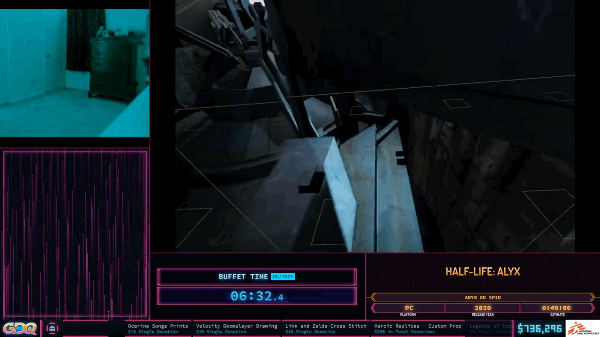gdq's first vr speedrun
history in the making
A not-insignificant amount of my attention this week has gone towards Summer Games Done Quick, the annual week-long showcase of video-game speedrunning skill and prowess. Despite it being a physically distant event this year, it remains highly compelling. The goal of any speedrun is to finish a game as quickly as possible, either by being really good at the game and/or intentionally breaking the game. It’s fun to watch people assert dominance over computers and break the computers’ arbitrary rules.
Late on Thursday night, I witnessed GDQ history in the form of its first VR speedrun, performed by Buffet Time (known otherwise as Daniel Turcich, a 24-year-old software developer). Almost immeditely, the run of Half-Life: Alyx turned incredible. I highly recommend watching it, though it might make you a little queasy at points.
A lot of speedruns rely on the runner being able to get outside of the boundaries of a level, glitching through walls to get to the finish line faster. In a standard game, this is a series of well-coordinated controller inputs. In Half-Life: Alyx, phasing through the environment at one point requires Turcich to get down on his hands and knees and scurry across his floor. The night-vision feed of his performance sorta looks like something out of Paranormal Activity.


All told, he finished the run in 31 minutes and 16 seconds. (The is not counting a presumed, additional 45 minutes of setup that I have to factor in whenever I play VR games because I have to keep recalibrating the software and updating drivers and the like.)
Anyway, Turcich was nice enough to hop on the phone with me yesterday and answer a few questions.
When did you first get into speedrunning?
In terms of speedrunning I got into watching speedruns in like 2010, 2011, and then I started to dabble in speedrunning around 2014. And since then I’ve done runs of Half:Life: Alyx, of course, Hotline Miami, Portal, Portal 2, a bunch of other games.
What is it about speedrunning that appealed to you?
I guess the entire appeal for me is the constant improvement and optimization. I think a lot of speedrunners tend to be in STEM fields – it’s just pure numbers. You can see your improvement very easily and it’s something that you can always keep improving and it’s very demonstrable your improvements.
What made you want to run Half-Life: Alyx?
The Half-Life series has been my favorite series for a while and I played Half-Life 2: Episode Two when it came out in 2007. I was among the people waiting 13 years for a new game. So when it finally was announced, I finally decided to get VR. I’d been thinking about it for a while. And then after playing it, it became my favorite game and also, it just so happens that it turns out to be like a really interesting speedrun.
Is there a lot of VR speedrunning?
As you can imagine, there’s a lot fewer people that have VR than other games, so they’re smaller communities. But there are quite a bit of people speedrunning, I would say, given the amount of people that have VR.
How do you go about developing a run like this? Is it particularly different from any other speedrun?
It’s pretty much the same process. The only thing is, with VR, you do have to take into account both the in-game reality as well as your real world, because there is a bit of a disconnect there that you could abuse. As you saw during the run, like sometimes we’re doing in-game movement, sometimes we’re moving in real life.
I was wondering if you could explain some of the main tactics you lean on for this run.
There is this thing called Height Adjust. Since it’s VR, they want to make it as accessible as possible. There’s a lot of different features that developers will put in to make it so that you don’t necessarily actually need to be standing to play the game. So Valve added a feature where you can bind to a button a crouch or a standing action. While you’re standing still, you can have it so that in-game you move down or move up.
So the crouch action will bring us down. If you’re standing up and then you press the button to go down, it brings your where you are in-game down, and if you then crouch in real life, you’ll get even further down. So you can end up going way lower than You’re supposed to and get underneath the floor. And the same thing works in reverse. If you perform a standing action while you’re laying down, and then you stand up, you get all that extra height.
And that lets you clip through the environment?
Yeah, so it’s these features that were designed for accessibility, but if you’re of able body, you can use them to get out of bounds in really interesting ways.
How long did it take to figure that out?
Right when the game came out, there was a bunch of us working together to find a bunch of different things. The height adjust was actually a pretty early find. There have been a couple of newer things, like the extended jump, which is basically: during teleport*, if you pause it at a very specific time during the teleport, then if you move in real life while you’re paused, and then when you unpause, you’ll go way further and then lets you clip through walls.
*VR games let users move by instantly “teleporting” them between where they are standing and another point in the virtual environment.
Is running the game tough on you physically?
Um, yeah, I mean, it definitely is. If you watch like the webcam, I’m doing a lot of crouching, a lot of laying down, popping back up, and just moving around – all that stuff. Even if you’re not doing that, you’re standing up for this extended amount of time with something heaviy on your head. I’m sort of used to it, I’m pretty into fitness. Before the pandemic, I would go to the gym very often. If you do multiple runs back to back, you will be physically tired.
This was GDQ’s first VR speedrun. How does that feel for you?
I guess it’s a pretty big honor. This is my second GDQ run. I did a run at SGDQ 2019 doing Lethal League Blaze. Even then I was like, I never thought I’d be able to get a run in. I just remember watching GDQ like forever ago and that now I’m the first person ever to do a VR speedrun is kind of nuts to me, I guess. I’m really happy that I was able to do it. I don’t necessarily think I deserve it, but that might just be like imposter syndrome, I guess.
SGDQ 2020 ends later tonight, and many of the runs are already archived on their YouTube channel. If you have time, I also recommend the Ocarina of Time randomizer run.
This week in sneaky changes
Instagram will now show users “suggested posts” in their main feed. Get more than two or three posts down and, assuming you’ve caught up on everything, the service will now start showing you personalized recommendations from people you don’t follow. In order to see old posts from people you do actually follow, you have to tap into a separate feed. If it sounds like Instagram trying to sneak in a TikTok-esque, “For You”-like feed through the back door, it’s because that’s exactly what Instagram is doing.
Tumblr rolled out a new timeline-sorting algorithm called “Best Stuff First,” which is not the reverse-chronological sorting that users have known for years. It was turned on by default without any signal to users. It can be turned off in the settings.
My thoughts on these changes are as follows:

Elsewhere…
“POV: you run into Ben Shapiro playing as catgirl in VRChat”
an extremely eclectics mix of things found on BOOTY (D:)
this is heinous but I would like to try at least one bite
oh:





